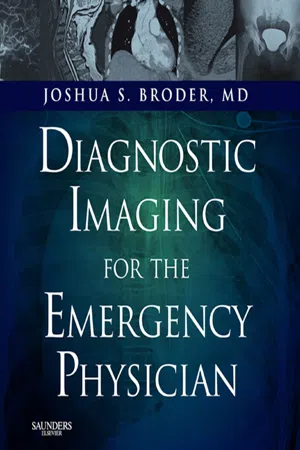
Diagnostic Imaging for the Emergency Physician E-Book
Diagnostic Imaging for the Emergency Physician E-Book
- 688 pages
- English
- ePUB (mobile friendly)
- Available on iOS & Android
Diagnostic Imaging for the Emergency Physician E-Book
Diagnostic Imaging for the Emergency Physician E-Book
About this book
Diagnostic Imaging for the Emergency Physician, written and edited by a practicing emergency physician for emergency physicians, takes a step-by-step approach to the selection and interpretation of commonly ordered diagnostic imaging tests. Dr. Joshua Broder presents validated clinical decision rules, describes time-efficient approaches for the emergency physician to identify critical radiographic findings that impact clinical management and discusses hot topics such as radiation risks, oral and IV contrast in abdominal CT, MRI versus CT for occult hip injury, and more. Diagnostic Imaging for the Emergency Physician has been awarded a 2011 PROSE Award for Excellence for the best new publication in Clinical Medicine.- Consult this title on your favorite e-reader, conduct rapid searches, and adjust font sizes for optimal readability.- Choose the best test for each indication through clear explanations of the "how" and "why" behind emergency imaging.- Interpret head, spine, chest, and abdominal CT images using a detailed and efficient approach to time-sensitive emergency findings.- Stay on top of current developments in the field, including evidence-based analysis of tough controversies - such as indications for oral and IV contrast in abdominal CT and MRI versus CT for occult hip injury; high-risk pathology that can be missed by routine diagnostic imaging - including subarachnoid hemorrhage, bowel injury, mesenteric ischemia, and scaphoid fractures; radiation risks of diagnostic imaging - with practical summaries balancing the need for emergency diagnosis against long-terms risks; and more.- Optimize diagnosis through evidence-based guidelines that assist you in discussions with radiologists, coverage of the limits of "negative" or "normal" imaging studies for safe discharge, indications for contrast, and validated clinical decision rules that allow reduced use of diagnostic imaging.- Clearly recognize findings and anatomy on radiographs for all major diagnostic modalities used in emergency medicine from more than 1000 images.- Find information quickly and easily with streamlined content specific to emergency medicine written and edited by an emergency physician and organized by body system.
Frequently asked questions
- Essential is ideal for learners and professionals who enjoy exploring a wide range of subjects. Access the Essential Library with 800,000+ trusted titles and best-sellers across business, personal growth, and the humanities. Includes unlimited reading time and Standard Read Aloud voice.
- Complete: Perfect for advanced learners and researchers needing full, unrestricted access. Unlock 1.4M+ books across hundreds of subjects, including academic and specialized titles. The Complete Plan also includes advanced features like Premium Read Aloud and Research Assistant.
Please note we cannot support devices running on iOS 13 and Android 7 or earlier. Learn more about using the app.
Information
Neuroimaging Modalities
| Clinical Indication | Differential Diagnosis | Initial Imaging Modality |
|---|---|---|
| Headache | Mass, traumatic or spontaneous hemorrhage, meningitis, brain abscess, sinusitis, hydrocephalus | Noncontrast CT |
| Altered mental status or coma | Mass, traumatic or spontaneous hemorrhage, meningitis, brain abscess, hydrocephalus | Noncontrast CT |
| Fever | Meningitis (assessment of ICP), brain abscess | Noncontrast CT |
| Focal neurologic deficit—motor, sensory, or language deficit | Mass, ischemic infarct, traumatic or spontaneous hemorrhage, meningitis, brain abscess, sinusitis, hydrocephalus | Noncontrast CT, possibly followed by MRI, MRA, or CTA, depending on context |
| Focal neurologic complaint—ataxia or cranial nerve abnormalities | Posterior fossa or brainstem abnormalities, vascular dissections | MRI or MRA of brain and neck; CT or CTA of brain and neck if MR is not rapidly available |
| Seizure | Mass, traumatic or spontaneous hemorrhage, meningitis, brain abscess, sinusitis, hydrocephalus | Noncontrast CT, possibly followed by CT with IV contrast or MR |
| Syncope | Trauma | Little indication for imaging for cause of syncope, only for resulting trauma |
| Trauma | Hemorrhage, mass effect, cerebral edema | Noncontrast CT—if clinical decision rules suggest need for any imaging |
| Traumatic loss of consciousness | Hemorrhage, DAI, mass effect, cerebral edema | Little indication when transient loss of consciousness is isolated complaint |
| Planned LP | Increased ICP | Noncontrast head CT—limited indications |
Computed Tomography
Noncontrast Head CT
Table of contents
- Cover
- Title Page
- Front Matter
- Copyright
- Dedication
- Acknowledgments
- Foreword
- Preface
- Table of Contents
- Chapter 1: Imaging the Head and Brain
- Chapter 2: Imaging the Face
- Chapter 3: Imaging the Cervical, Thoracic, and Lumbar Spine
- Chapter 4: Imaging Soft Tissues of the Neck
- Chapter 5: Imaging the Chest: The Chest Radiograph
- Chapter 6: Imaging Chest Trauma
- Chapter 7: Imaging of Pulmonary Embolism and Nontraumatic Aortic Pathology
- Chapter 8: Cardiac Computed Tomography
- Chapter 9: Imaging of Nontraumatic Abdominal Conditions
- Chapter 10: Imaging Abdominal and Flank Trauma
- Chapter 11: Imaging Abdominal Vascular Catastrophes
- Chapter 12: Imaging the Genitourinary Tract
- Chapter 13: Imaging of the Pelvis and Hip
- Chapter 14: Imaging the Extremities
- Chapter 15: Emergency Department Applications of Musculoskeletal Magnetic Resonance Imaging: An Evidence-Based Assessment
- Chapter 16: “Therapeutic Imaging:” Image-Guided Therapies in Emergency Medicine
- Index